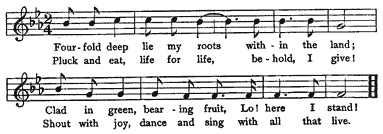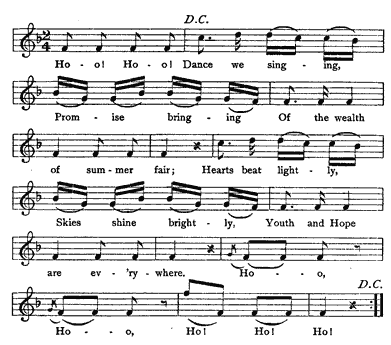The Life of the Corn
by Alice C. Fletcher
A Drama in Five Dances
INTRODUCTION.—These Dances in their purport and music are taken from the sacred rituals of the Omaha, the Osage and the Pawnee tribes. The richness and beauty of symbolism in the original language suffer a loss of native naïveté in their English interpretation.
The American food plant known by the general term "Corn" was developed ages ago from certain native grasses. The Euchlaena luxurians found in Guatemala is probably an ancestor of the maize. The word "maize" belongs to the language of a people (known as "Arawaks", or as some say "Island Arawaks") living by the Caribbean Sea and never was a universal term for corn among the Indians of our country. The tribes to which maize was known gave it a name derived from their own languages. So very many centuries have passed since corn was a grass that there is no way now of finding out when in the remote past the natives of this continent began the task of developing from a grass a staple article of food like the corn. The process required years of careful observation, manipulation and culture. Not only did the Indians accomplish this task but they took the plant from its tropical surroundings and acclimated it throughout the region east of the Rocky Mountains up to the country of short summers in the North; Cartier, in 1534, found it growing where the city of Montreal now stands.
From this hasty glance at the long history of the maize we can discern the natural sequence of its close relation to the thought and to the life of the Indian, and to a degree understand the love and the reverence with which the corn was held and regarded as a gift from God. Every stage of its growth was ceremonially observed and mentioned in rituals and songs.
Among the Omaha tribe when the time came for planting, four kernels from a red ear of corn were given to each family by the keeper of this sacred rite. These four red kernels were mixed with the ordinary seed corn, that it might be vivified by them and made to yield an ample harvest. Red is the symbolic color of life. In this ceremony is preserved a trace of the far-away time when all the precious seed corn was in the care of priestly keepers. The ceremony of giving out the four red kernels served to turn the thoughts of the people from a dependence solely on their own labor in cultivating corn to the life-giving power of Wakon'da dwelling within the maize.
In the Omaha Ritual Song of twenty-six stanzas which preceded the distribution of the four red kernels, the Corn speaks. It tells of its roots reaching in the four directions (where dwell the messengers that bring life), of the growth of its jointed stalk, of the unfolding of its leaves, of the changing color of the silk and of the tassel, of the ripening of the fruit, of the bidding of the people to come, to pluck and to eat.
The music of this Ritual Song is simple. It is here given with a very brief paraphrase of the words of the Ritual Song.
DANCE I - The Corn Speaks
INTRODUCTORY NOTE.—This ceremonial dance touches upon the mystery of the giving of life that life may be maintained; an exchange that links together the different forms of life and enhances the joy of living.
Properties.—Thin green mantles; yellow plumes like the corn tassel; bone clips; as many of these articles as there are dancers.
Directions.—This dance belongs to both sexes and a number of each should take part, if that is possible. Should there be trees near the open space where the dance takes place, one-half of the dancers, closely wrapped in their green mantles, should be grouped at one side among the trees and the other half similarly placed at the other side. In the center of the space a single dancer stands facing the rear, wrapped about the head and body with the green mantle, leaving only the face exposed.
All being in readiness, the central figure turns slowly, lifts a draped arm and says slowly and impressively:
"Harken! The Corn speaks!"
The group of dancers on the right then sing softly the first line only of the Ritual Song in which the Corn speaks. The group of dancers on the left repeat the same line like an echo of the first group. Both groups of dancers now begin to move slowly and in rhythm with the following song toward the figure standing in the center of the space, singing, as they move, the Ritual Song from the beginning:
Ritual Song No. 1
Fourfold deep lie my roots within the land; Clad in green, bearing fruit, Lo! here I stand! Pluck and eat, life for life, behold, I give! Shout with joy, dance and sing with all that live.

At the words "Lo! here I stand!" the company of dancers should all be standing in a semi-circle. As the words in the third line, "Behold, I give!" are sung, the draped arms should be slightly extended forward as in a presentation. The fourth line requires some dramatic action, but it should be restrained rather than free. The arms, still draped with the green mantles, should be raised a little as the words "Shout with joy" are sung, and during the singing of the remainder of the line swayed from side to side in rhythm with the song, always with a reserve in the movements, because of the mystery mentioned in the words of the song, that life is maintained by the giving of life. A pause of about two beats should follow this Ritual Song.
As "Ho-o! Ho-o!" the opening of the next song, is given, every dancer should suddenly turn half-way round, give a movement of the head such as would cause the mantle to fall back and leave the head with the corn tassel exposed; the ends of the mantle should be gathered in the hands so that the mantle can wave with the dance as the following song is sung:
Song No. 2
Ho-o! Ho-o!
Dance we singing,
Promise bringing
Of the wealth of summer fair;
Hearts beat lightly,
Skies shine brightly,
Youth and Hope are ev'rywhere.
Refrain: Ho-o! Ho-o! Ho! Ho! Ho!

As each "Ho-o!" of the refrain is sung, the dancers should whirl like merry sprites, twine and untwine their green mantles about their forms until the song begins again. Then they should all skip off with springing, rhythmic steps in open Indian file, letting their mantles float and wave about them as they wind in and out over the camp ground carrying "Youth and Hope ev'rywhere." Every time the refrain is reached, the dancers should stop and whirl, then as the song begins again move off in line, dancing as before. When they are ready to stop (that can only be done during the singing and whirling of the refrain), each dancer should whirl from the line and keep up that movement, singing "Ho!" until his or her tent is reached.